I didn’t know where I was heading and what I am going to see when I entered 23 hours long ferry going deeper into unknown Borneo. Curiosity about the Dayak people from East Kalimantan led me. The cruise was long, scary and it wasn’t sure that all the journey is worth it. What I finally saw and experienced was absolutely unbelievable. I took part in tribal rituals that probably will vanish in a couple of years. The traditions so old, that are not understandable for the modern society. But let me tell you the story from the beginning and describe Dayak tribe and their customs a bit.

Traditional Dayak dance.
Why taking this crazy journey?
My journey around Borneo was long and took nearly three months. I started from Kota Kinabalu, later went to the rainforest in Brunei Darussalam. This is where I learnt about Dayak people which are native inhabitants of the whole Borneo. I was curious to learn about the old traditions and see, if still possible, the authentic rituals, not just the show for tourists.
Going through Sabah in Malaysia, I stopped for a wildlife watching in Kinabitangan River as well as Danau Valley. When I crossed the border, I decided to visit Kutai National Park in East Kalimantan for wild orangutans watching as well as pristine Derawan Islands for a bit of paradise relax. All this way I heard about Dayak people but couldn’t see signs of them anymore. Some locals told me that I can only see real Dayak tribes who still follow the traditions in the center of Borneo. But how to go deep in Borneo – I asked? Well… it ain’t easy.
How to see Dayak traditions in Borneo?
 Traveling around Borneo, you will have a chance to see the traditional longhouses of Dayak tribe preserved like a museum. Not only they will show you traditional bamboo cooking, but also how to make a fire and use the blowpipe. However, be aware that these are all prepared for tourists.
Traveling around Borneo, you will have a chance to see the traditional longhouses of Dayak tribe preserved like a museum. Not only they will show you traditional bamboo cooking, but also how to make a fire and use the blowpipe. However, be aware that these are all prepared for tourists.
Coming to East Kalimantan, I had a chance to go for a traditional Dayak dance which was also a touristic show but absolutely worth it. It was near Samarinda in Pampang village. Traditional hornbill dance, typical for Borneo was magnificent. How many times I saw it already on the weddings in Semporna, as the married couple, even though they had Muslim wedding ceremony. It’s the Dayak tradition and all the people from Borneo are Dayak from their origin, after all. A Hornbill is a type of bird with a giant beak, symbol of the Dayak tribe.
Some locals told me that going up the Mahakam River will take me to see Dayaks of East Kalimantan. I did the research, and the only chance to see them was a touristic Mahakam River cruise which would take me to the traditional village, doing the show I didn’t want to see; seeking for something more authentic, experiencing the true people, not the touristic program that follow a schedule and appear as they want me to see it. I have to admit the cruise I mention ain’t cheap. Mahakam River cruise price is minimum $200 per person! And if you think that the cruise on the river is like diving into the jungle, sorry to disappoint you, the jungle is already gone.
Finding an alternative
My adventurous part told me to go deeper, see what tourists can’t see! On the other hand, finding an alternative was nearly impossible. I have to confess my solo journey around Borneo was one of the most difficult ever. No hotels, no touristic infrastructure, no regular buses, nobody speaking english, poor internet signal and Google giving me no answers to my questions (yes, it turns out that uncle Google does not know everything). Traveling alone was a nightmare, so were the distances and roads which I would say didn’t exist, if comparing with the road standards I am used to. So where to sleep, how to move on, how to go around safely by myself, when I don’t know where not to go? All these questions were killing me all the way long, at the same time the curiosity and wanderlust were pushing me farther.
What I was doing to survive (literally!) was asking people, who I met through couch surfing or hitch hiking, if they know someone in Central Borneo. All the people on the way, who felt trustable were trying to find a solution for me. It didn’t look promising, as Borneo is a huge island (third biggest in the world) and people usually have friends and family nearby. Before I nearly had given up that I can do it, before I nearly booked a ferry to leave Borneo, I saw the light in the tunnel giving me hope.
Through the network of contacts, finally a person who I never met recommended someone and a tiny contact was opening to me. An Indonesian girl living somewhere deeper in Borneo where the Mahakam River leads. The obstacles were not over though, as she didn’t speak english and contact with her was so unclear and tough that I was not sure to go. Reading some words pasted out of Google Translate were not explaining me where I should go, where I can stay and also not promising me that I will see some Dayak traditions.
After a long soul-searching I decided to take a chance – this was a once-in-a-lifetime opportunity, after all.

The public ferry had two floors. The upper part was really comfy with mattresses.
Taking a public ferry on Mahakam River
Normally, when someone says, that I am brave to travel solo around Asia, I say it’s nothing special. This trip, I have to admit, was a crazy decision and was indeed brave or, as other people see it, stupid. With the sunrise I entered the public ferry on Mahakam River in Samarinda. Wooden old ferry looked like it can break down any moment, but was unexpectedly comfortable. Nobody spoke English, no tourists, around a hundred of locals packed together and unknown adventure ahead. I got a comfy place for this 23 hours journey with a mattress and a pillow. Above me there was also a plug to charge – what a luxury! There was no signal, but I could open my laptop and start a draft of this post. Downstairs, little bar and toilet hole to pee directly to the river. In the same river you got to take a shower and brush your teeth, if you wish. Locals do that in the villages all along the Mahakam River.
The views from the boat were beautiful. Peaceful banks with paddy fields and beautiful sunset from the boat front with some teenagers laughing at me. I have to admit, I really enjoyed this long Mahakam River cruise with a public ferry. There was everything I needed, nobody was disturbing me, I could rest. It reminded me taking the boat on Mekong River between Thailand and Laos. River feels so relaxing.
To be honest I imagined Mahakam River cruise as going deep inside the rainforest. Twenty hours going into Borneo and I haven’t seen any. I also didn’t encounter any wildlife, was hoping to see proboscis monkeys on the trees or some crocodiles on the banks. The rainforest is gone because of villages, mines and extensive palm oil plantations. This is actually the saddest thing about the Borneo Island, which I could witness during the whole trip. Tourists come to Borneo to see wildlife and have to go through hundreds of kilometres of the palm oil plantations to see a little enclave where the rainforest is left. Wildlife watching became a very expensive prestige, that not everyone can afford.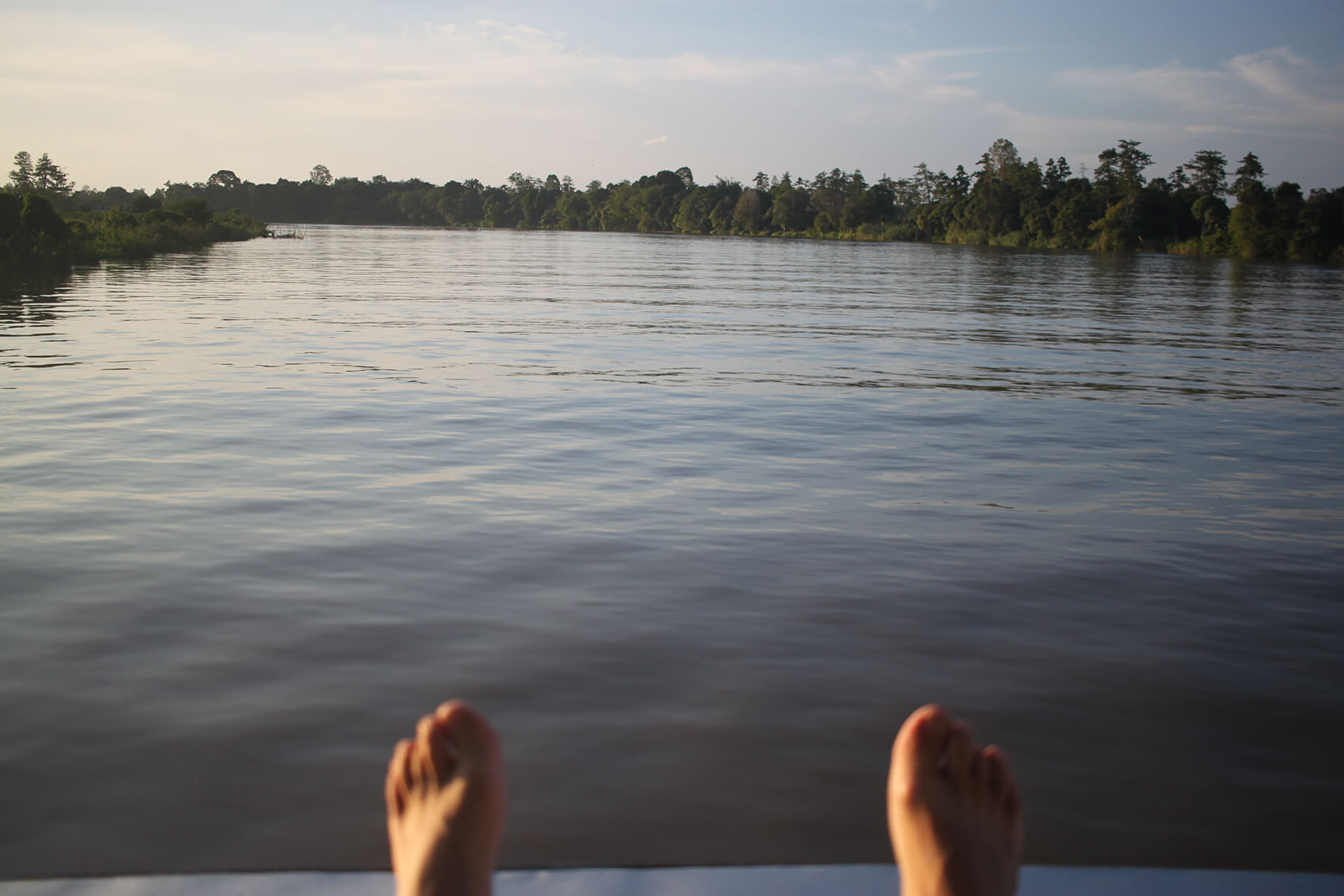
Arriving in the middle of nowhere
You know I have this thing with maps, that I like to know where I am. Plus I have really good orientation in the field. I felt uncomfortably lost when I arrived to some dark place in the middle of the night. I seriously, awfully didn’t know where I am and when/if the girl I talked with will come for me. Google wasn’t on my side either.
All the people left the boat apart from me, the captain and one more passanger (of course male). I had the choice of walking out in the darkness or stay on the boat for the rest of the night. The company of two men wasn’t safe either, but from these two I chose to stay. I tried to explain to the captain in the body language showing the clock and speaking English, that I would like to stay on the boat until the morning, if possible. He agreed.
I was so freaking scared, if they are not going to rape or rob me. The guy was talking something to me, but I had no clue what. But he was friendly. Certainly, I couldn’t sleep. With the sunrise, there was hope. A woman in the veil, who looked as scared as me, came to pick me up. She took me to her house, gave a room of her son. I was safe! I was extremely relifed!
Introducing the Dayak of East Kalimantan

Originally Dayak people were wearing attire with feathers and leader with long earrings and tatoos.
My host Yana is wanderlust like me, fascinated in the old Dayak tradition and being proud of it, even though she is a Muslim and originated in another part of Indonesia. Together with her husband and online translator, she explained me a bit about the region. She said that most of the people live in the modern way, globalisation came here as well. However, there are still some carrying the old tradition or living in the traditional longhouse.
I couldn’t wait to see some authentic longhouse and if am lucky, participate in the traditional ceremony. But first things first. Let me introduce the Dayak people closer.
Borneo Island had over 200 hundred Dayak tribes which customs vary from region to another. Where I was, in Kutai Barat province, were Dayak Benuaq. The majority is now Christian, but some still believe in the power of old rituals from Kaharingan – the animist religion of the Dayaks. However, like everywhere around the world, less and less people carry the tradition and it seems like in a couple of years it will be all gone.
Dayak people are the ancestors of the famous headhunters. Head is the most important part of the body, because Dayak people believe, that the soul is there even after death. Headhunting between tribes was very common on the Borneo Island. But it’s not just here the head hunting was practiced. When I was discovering mysterious hanging coffins in Sagada, Philippines, I learnt that one of the reasons for hanging the dead high on the cliff was the risk of stealing his head by the enemies.
Meeting the real Dayaks
We were going around by car when Yana saw something. A gathering of people in front of one house could mean the traditional ceremony. We stopped the car, and Yana went there to have a look and ask, if they could agree for a stranger to come and eventually make some photos. The hosts were happy to welcome me for the traditional Dayak healing ceremony.
Beliant Bawo is the name of the Dayak healing ceremony for a woman. I was invited to a simple wooden house where I saw the preparation for the ritual. The old lady laying down looking very tired, something like a box-shaped altar hanging inside the house with lots of symbols I couldn’t understand. Children banging in the drums and gamelan in the synchronous rhythm and smell of incents pushed me to see what’s outside of the house.
Everything looked like there is going to be a huge feast – the gathering of the family and neighbours, a massive pot with boiling water and ladies bustling all around. I noticed a sacrificial altar in front of the house, where a black pig and a few black chickens were tided up. The pig breathing heavily from the fear made me realise, that this is not a joke, magical fairy tale, and maybe it was better to stay with the touristic crap. This was a real shit going to happen that started to scare me off.

Me in the Dayak attire
Witnessing the traditional Dayak ritual
People explained me that the lady came back from the hospital still sick, so the family decided to organise the Dayak healing ceremony hoping that if the doctors didn’t help, the old rituals will. Here came the shamans. Three old ladies (as man shaman are for a man ceremonies) commenced the ritual by praying in the sacrificial altar in front of the house. Doing some signs with hands they took some feathers from the scared chicken and threw them in the air. They did the same with the pig bristles still whispering. Drums were going louder and louder what is suppose to induce spirits to come.
The sacrificial altar was full of offerings, decorations and symbolic attributes which I had no idea what they were. Some sort of cans or plates with herbal pastes and boxes with a mysterious mixture. My attention grabbed statues out of something like a clay, with big mouth and eyes like out of some crepy horror movie. They might be the symbols of servants which help the soul when traveling.
Suddenly, one lady put a sharp knife in the throat of the pig on my eyes. The pig started to choke with blood. Ritual killing moved to the three black chickens. The sacrifice was made, the spirits awake, it was time to move everything inside and start the healing. The ladies collected a bit of the blood from each animal to the bowl. Few other ladies and myself, helped to move all the attributes inside: scary figures with big mouth, various leaves, pastes, rice, water and some others hard to describe. Black magic, shamans and whole this psychodelic atmosphere was freaking me out.
Dayak healing ceremony
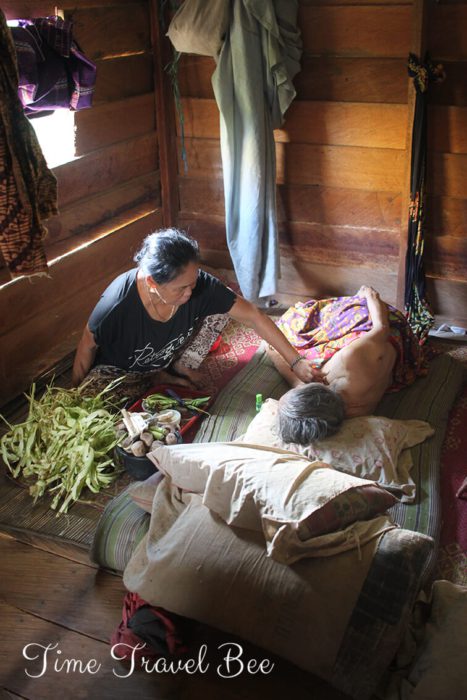 The shamans marked their faces with animals blood on the forehead and temples. Having all the offerings under the interior box-shaped altar, they started to dance around. One shaman finally took all the attributes to the sick lady and started the prayers. It lasted for a long time, meanwhile marking the old lady with sacrificed blood, pastes, water, and other mysterious substances one after another. Dayak people believe that the healing ceremony helps to retrieve the soul traveling from earth to the Upper-world – land of the dead.
The shamans marked their faces with animals blood on the forehead and temples. Having all the offerings under the interior box-shaped altar, they started to dance around. One shaman finally took all the attributes to the sick lady and started the prayers. It lasted for a long time, meanwhile marking the old lady with sacrificed blood, pastes, water, and other mysterious substances one after another. Dayak people believe that the healing ceremony helps to retrieve the soul traveling from earth to the Upper-world – land of the dead.
The Dayak healing ceremony takes the whole day. During this time family prepare the feast based on the sacrificed animals. They quickly started to clean the pig from skin and guts while the chickens landed to the huge pot with boiling water (the animals for the black magic have to be black). Everyone has to eat the feast to accomplish the healing. Even though I didn’t stay until the feast, they asked me to eat a spoon of rice, as leaving without eating something would be not good for the success of the spiritual ceremony.
Seeing traditional Dayak villages
At the first glimpse, the villages in Kutai Barat looked like in the other parts of Indonesia. However, I could see plenty of Dayak longhouses, not the ones maintained for tourists. I had a chance to visit one of them inside, where the families still live. It was around hundred meters long wooden house, with flats attached to each others and long corridor. Long time ago, humans life in Borneo existed only in longhouses. The buildings were often along the river bank, to have the protection from one side.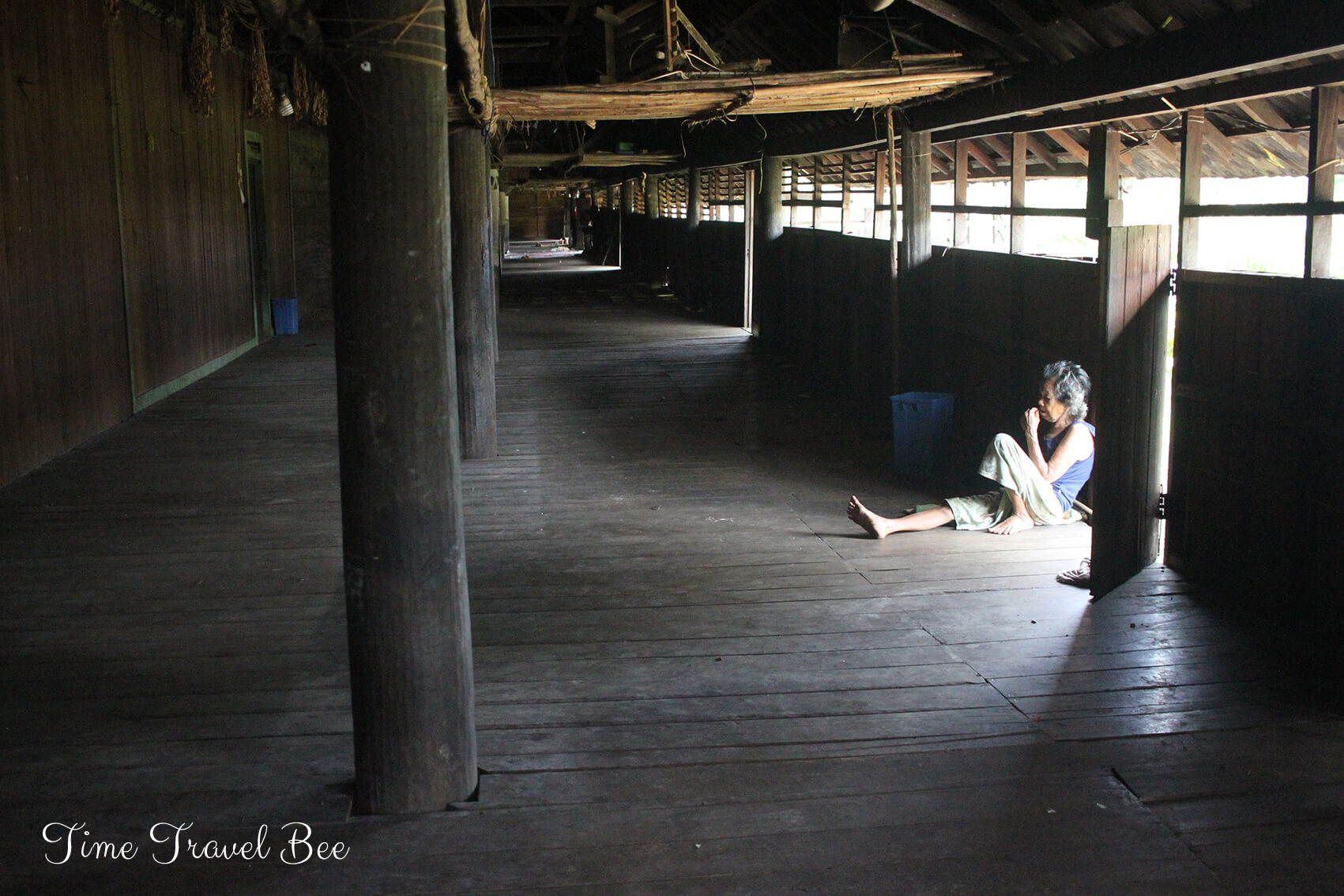
The longhouse stands on stilts for protection as well. Another difficulty to access for the enemies or wild animals made “stairs” carved in a piece of log. For the night the log was turned up side down, so that it would be really hard to climb on the slippery side.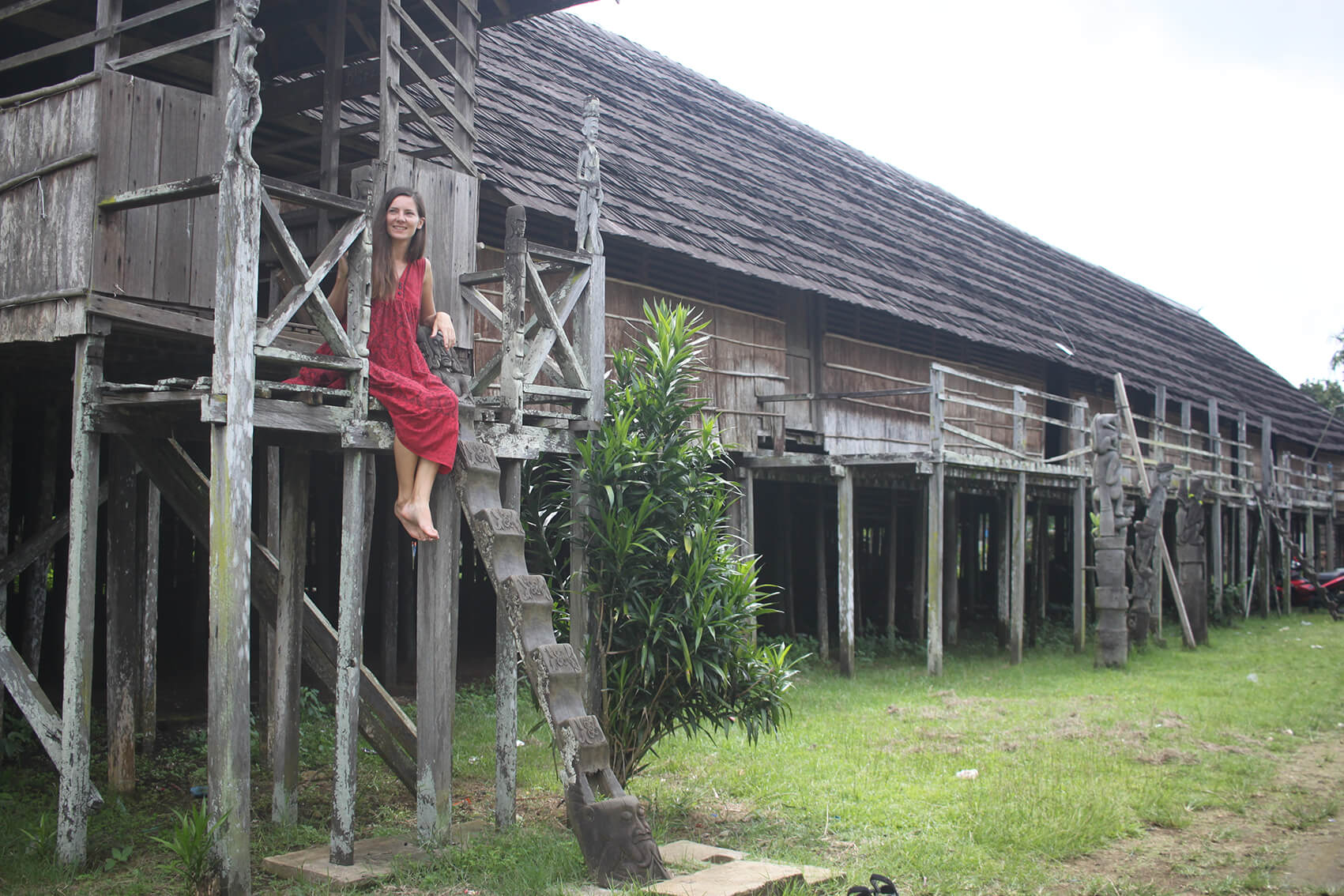

In front of the longhouse, as well as many other houses I saw stupas. It’s a wooden piece of art put as a memorial of the one deceased or for the whole family. Incredible sculptures made by local artists were like an art gallery for me. I also went to the workshop and saw new stupa coming out.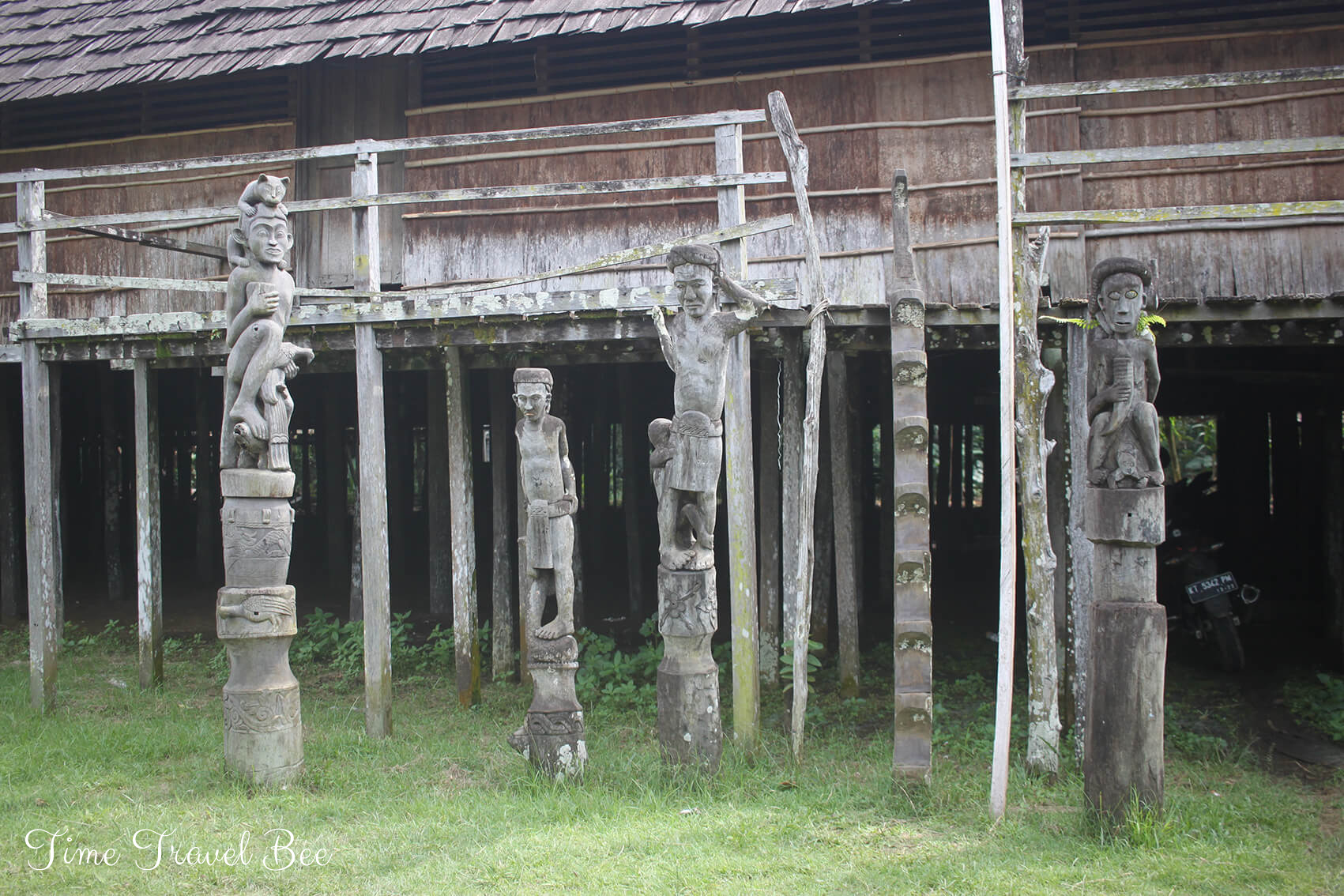
Talking about the local artists, Dayak people are famous for weaving rattan, a special kind of grass that is used for the bags (famous also in Bali), furniture, decorations or baby carriers. In fact, I couldn’t see people wearing traditional clothes, except for the ceremonies, but I could see numerous Dayak people wearing rattan bags on their daily basis. I also went for some local shopping, getting bags and Dayak tea from a red onion.
Dayak people wear their traditional clothes only for ceremonies and special occasions. They say traditional clothes are time consuming to make as they are handmade, or expensive, if you want to buy them. Like everywhere around the world, people became lazy and our global village provides cheap second hand shops where you can buy t-shirt from Bangladesh for $1.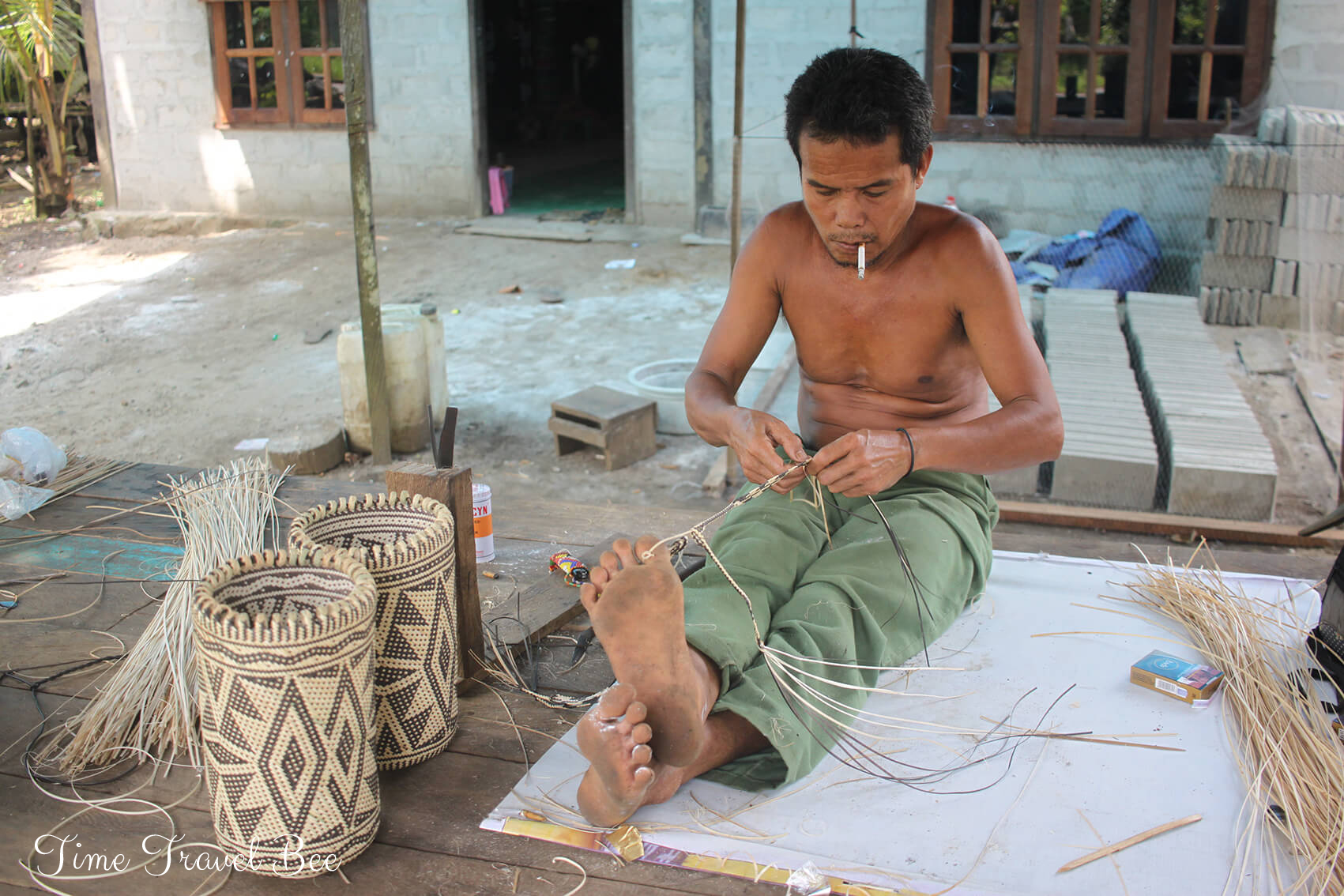
Dayak Ceremony for the dead
The other day my host Yana got a leak from a friend about the traditional Dayak ceremony for the dead. I felt a bit nervous when we were going there and excited at the same time. I wasn’t sure how I should behave as the custom was completely new to me. In my country (Poland) it would be disrespectful to laugh on the funeral, and cemeteries are places of reverie and silence. In Europe, I saw one exception, the unique Happy Cemetery in Romania, the only cheerful cemetery in the world. The death ritual of the Dayak people wasn’t sad. I could feel the atmosphere of meditation, however, the ceremony is meant to make the soul of the deceased happy.
There are two types of rituals for the deceased in the Dayak tradition. First one is just after death, second one can be many years after death for giving respect and remembering the person. In the religious meaning, the ritual aims to straighten the trip of the soul to the Heaven so that he can live in peace. Earthy, it’s believed that when the family has some bad luck, it means some deceased are asking for prayers. This ritual releases the bad luck and let’s the family live in peace.

Man shaman praying on the ceremony for the dead.
How does this ritual look like in Dayak tribe of East Kalimantan? Every day will be fulfilled with singing and praying along with synchronous playing on gongs and gamelan which leads to put everyone in a kind of trance. They offer food every day for the deceased – for breakfast, lunch and dinner. In the evening, there are traditional Dayak dances around the box-shaped altar hanging from the selling. Above it I saw really crepy looking pieced of plates and glasses hanging on the strings.
There was a ball wrapped in the textile on the back of one of the dancers. I noticed they were switching and with each dancing circle someone else was carrying it. As an observer, I was curious what’s in there. Yana explained me that there is a coconut as a symbol of the skull, as the person has just died. In the rituals for the deceased long time ago they take a real skull from the grave. Swinging it in a dance is believed to wake up the spirit.

All the offerings are for the dead.
The ceremony can take one week or even one month, if the host decides. It basically depends on money the hosts can spend as every day they have to organise a feast for a bunch of people, pay shamans, pay the venue, if it’s not in their house as well as sponsor the stupa. It’s a huge event with rites and prayers repeated every day preceded with a long preparation. It’s also an event when many pigs, chickens or even buffalos (if the budget allows) will finish their lives. To maintain the expensive event, there is often gambling along, that helps family gain some extra money and the guests to have fun. Don’t forget that here funeral is not a sad ceremony, it should make the soul happy.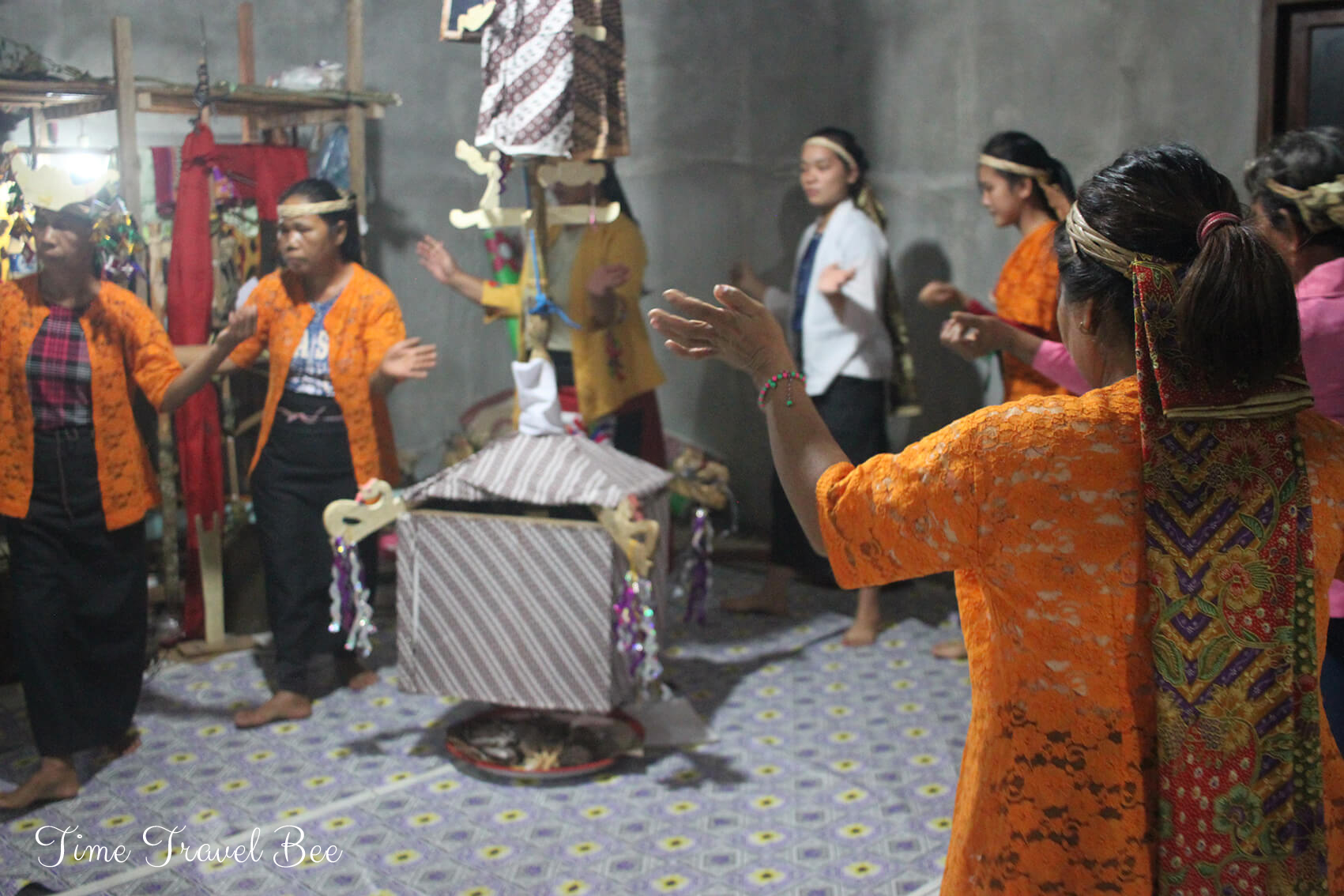
Dayak people now
I spent a week being a guest of a lovely family which took a great care of me, fed me and show me around. I can’t describe how glad I am that I met them! When I was leaving, I was hiding tears and I was not thinking about the traditions I have seen. Now, when I can recall these events from perspective, I still can’t believe it was really happening. I saw old tools and rituals, dances for the soul, funeral celebrations, healing ceremony and it feels really sad that Dayak tradition will vanish soon.
Over the last century, most of the Dayak people converted to Christianity, abandoned certain cultural rites and ancestors practices. All Dayak God and Deity has been labeled as mythology because Christians are not allowed to worship them anymore.
Another sad fact about Dayak people I haven’t mentioned before, is that they have been driven off their lands by logging schemes, palm oil plantations, deforestation and other issues. Most commonly, the developers used the fires as an excuse to clear land that belonged to the Dayaks to make palm oil plantations. Dayak tribes are one of the most marginalized ethnic groups in Indonesia and Malaysia. Sadly, their traditions disappear as fast as disappears the jungle of Borneo…

My host family in Kutai Barat

Beautifully carved grave of Dayak people.
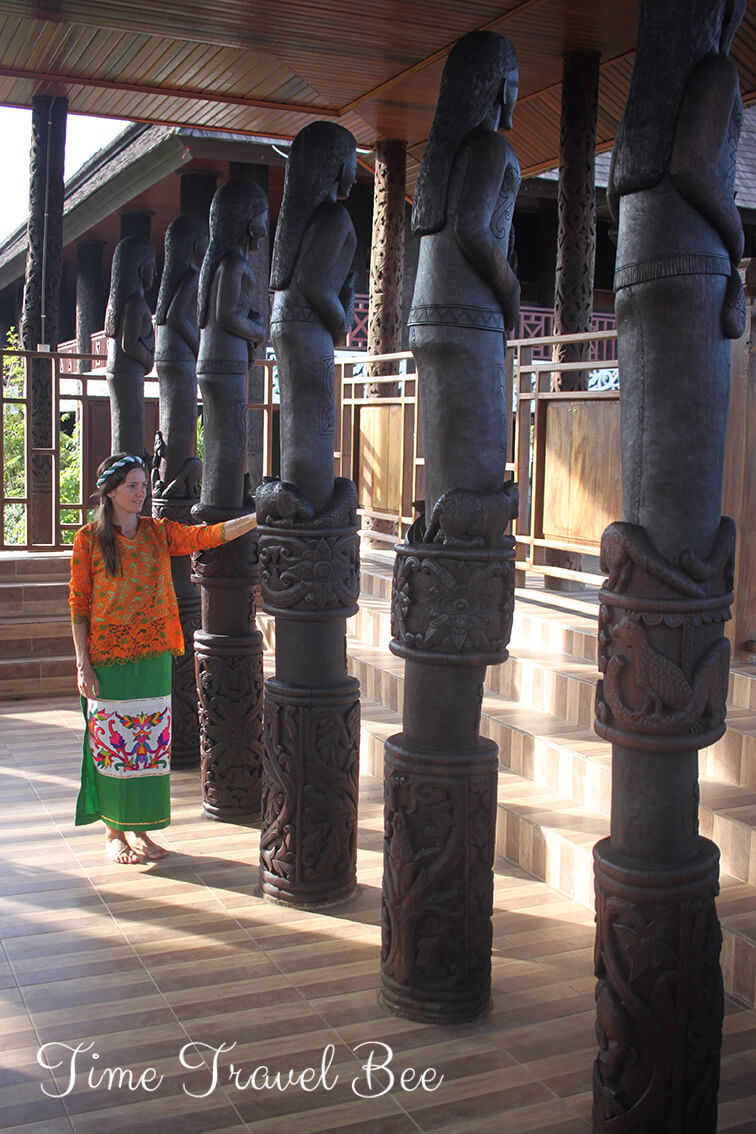

Mahakam River Cruise

some of the attributes used in rituals of Dayak people

She made me a rattan bracelet in just 3 minutes.
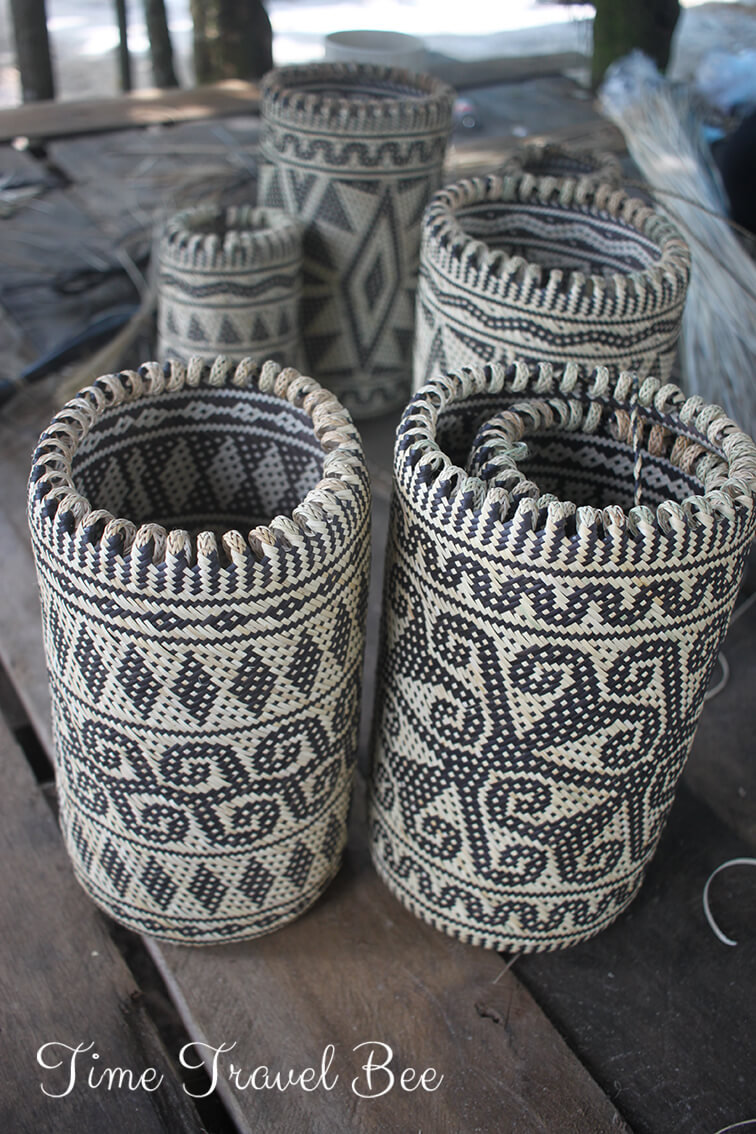

Every day offering for the dead are not just food but also cigaretts, if he was a smoker.
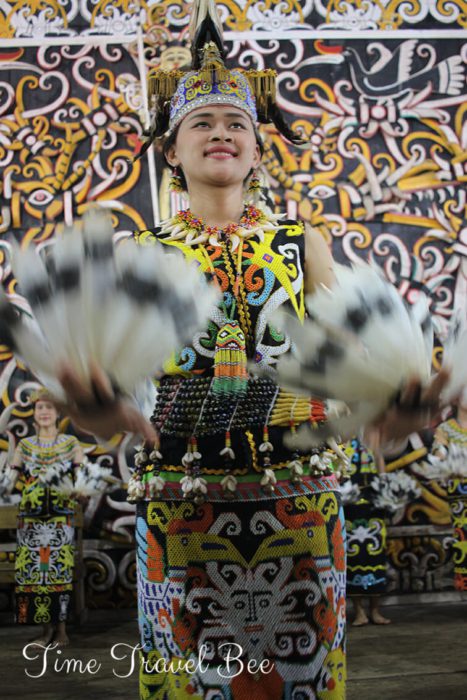
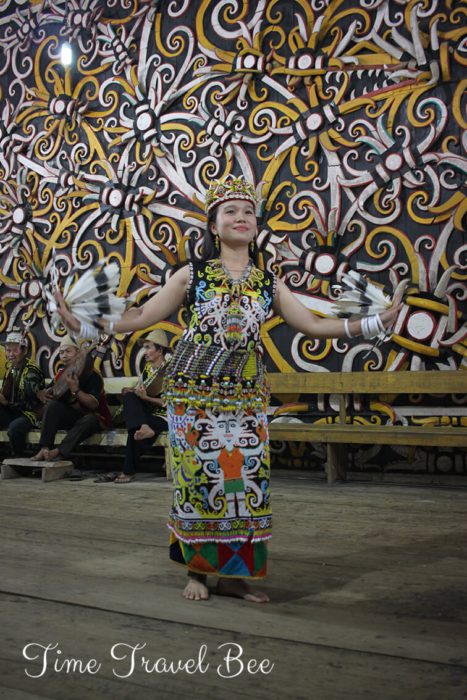
The Bee is a nature lover and tea addict. Loves the idea of slow life and responsible traveling, constantly trying to improve to bee more eco-friendly. Appreciates old cultures and traditions, loves to immerse with locals, listen to ethnic music as well as taste regional food and drinks. Her favorite spots while traveling are family houses and street markets.



I absolutely loved this article. It is incredible hearing about the adventure that you had. It seems like it was challenging but at the same time it gave you so much to experience. It is so good when you manage to get outside of the touristy areas and actually get to see how the locals live. It is really brave of you and everything you had to go through!
The tradition ritual seems like an incredible thing to witness. I would also love to visit the genuine Dayak longhouses that is still lived in. What in incredible and rare insight into this culture!
Borneo is high on my travel bucket list but this looks like a special experience that I never knew about. I love the attire (so colorful and interesting). How was the healing ceremony? That seems cool.
Cool is not a good word to describe the healing ceremony 😀 It was mysterious, scary and magical.
Really nice information. Indigenous culture is very fascinating all around the world. Borneo has been on the top of my travel bucket list but I had no idea that Dayak people have such a rich culture.
Meeting local people is one of the best things about traveling for me. It provides a more authentic experience and allows you to get to know the place you are visiting better. Very nice post, lots of interesting information and beautiful photos!
It’s wonderful that you had such an intimate experience there. The healing ceremony in particular strikes me as an experience that you’ll absolutely never forget for as long as you live. You’ve convinced me to research this a bit more!
Your photos are amazing! This is the perfect destination for a trip. Reading your blog has definitely got me thinking about coming up with a plan to visit Borneo in the future at some point.
Witam.Ciekawa historia.Mam zamiar wybrac sie w rejony Dajaków.Czy mozesz napisac mi gdzie tzn do jakiej miejscowosci doplynelas z Samarindy?